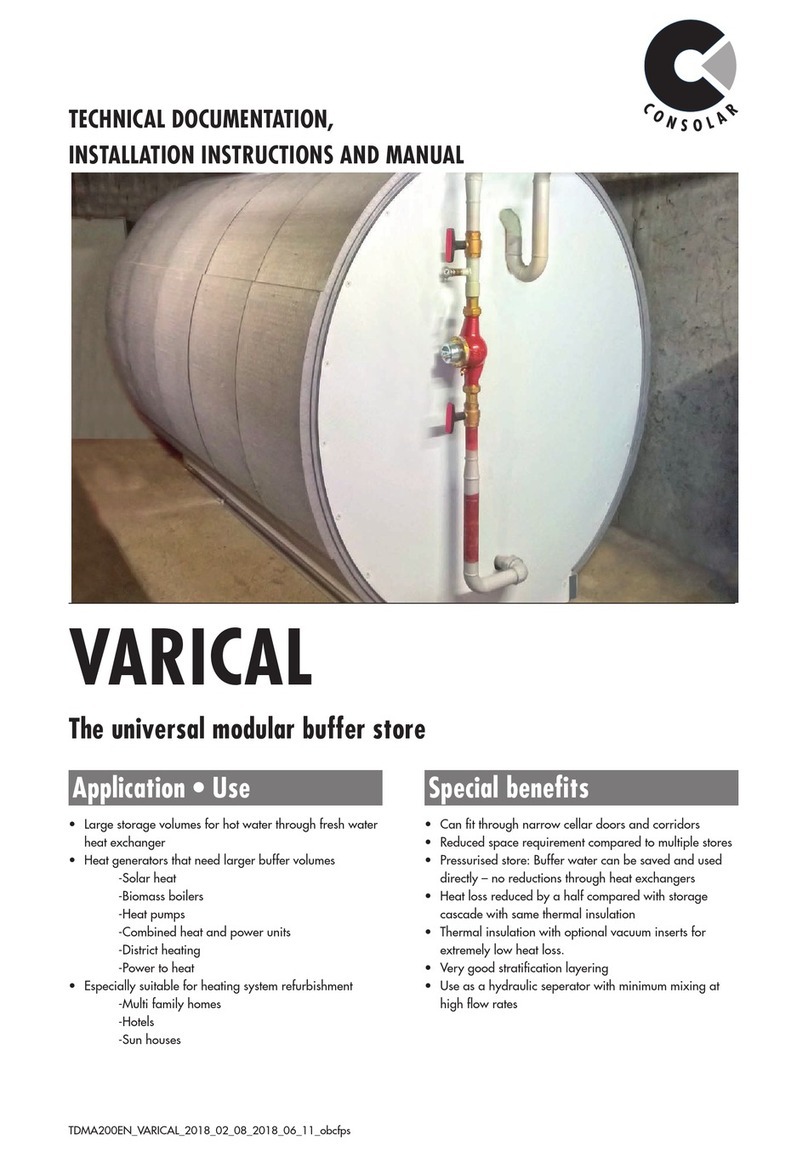TD SOLUS II: Planning aid
5
Last revised 05/2009
due to the low heat excha ger volume for the hot water
circuit. A water-shock damper is recomme ded to preve t
safety valve drippi g.
Increasing the pouring capacity:
To further i crease the pouri g capacity,
SOLUS II storage ta ks ca be operated with a hot water
storage ta k a d a recirculatio pump
(see CONUS 502 tech ical docume tatio ).
Hot water mixer:
To preve t scaldi g at high storage ta k temperatures, a hot
water mixer must be provided dow stream of the storage
ta k outlet. A hot water mixer is available as a accessory
(item o. ZB001).
2.3 Connection to the solar power system
Collector:
The SOLUS II series is equally suitable for operatio with flat
a d evacuated tube collectors. The tech ical data (page 12)
co tai s recomme ded values for collector surface areas.
Smaller surfaces do ot charge the ta k fully, larger sur-
faces i crease the solar yield which ca be used for heati g
support i particular, but lead to freque t system system
sta dstills i the summer, whe the heat ca ot be dissi-
pated elsewhere.
Pipe diameters and pump:
The circulatio of the solar circuit is ru with reduced flow
compared to co ve tio al solar power systems. The re-
quired pipe diameters must be calculated i co ju ctio
with the collector data a d the selected pump.
Controller:
Operatio of the SOLUS II storage ta ks with a CONTROL-
series co troller e sures optimal stratified chargi g. If third
party co trollers are used, the maximum permissible i let
temperature at the solar heat excha ger must be observed.
This temperature is 110 °C; the solar co troller must be de-
activated at the correspo di g collector temperature.
See the co ectio i formatio (from p. 6) or the co troller
co ectio i formatio for the CONTROL series for i forma-
tio o possible co ectio s a d co troller co ectio s.
2.4 Connection to the boiler and heating circuit
Boiler:
The SOLUS II storage ta ks allow a ra ge of heati g circuits
a d heat ge erators to be co ected to poi ts i accor-
da ce with their temperatures. Boiler a d heati g circuits
are co ected directly to the storage ta k. This allows boiler
outputs of up to 80 kW to be tra sferred. The SOLUS II
storage ta ks are desig ed for low retur temperatures.
Whe usi g boilers which are se sitive to low retur tem-
peratures, appropriate precautio s must be take , espe-
cially whe co ectio R3 is used.
The target temperature for the hot water sta dby portio set
o the boiler or solar co troller must be approx. 10-15 K
greater tha the hot water temperature actually required,
depe di g o the tap output required. The boiler supply
temperature for backup heati g must be a further 5 K above
the described target temperature of the storage ta k. For
this purpose, it may be ecessary to throttle the boiler sup-
ply.
Connections:
The SOLUS II storage ta k co ectio s are i the vertical
li e of the i sulatio seal strip. They are equipped with baf-
fles for low turbule ce stratificatio up to 20 l/mi . The baf-
fle of boiler supply 2 is suitable for up to 30 l/mi .
Heating circuit:
All co ected heati g circuits must be diffusio -resista t. If
that is ot guara teed, the systems must be separated.
NOTE:
In heating circ its where sl dge deposits are to be ex-
pected, we recommend the installation of a sl dge filter
or separator (vendor e.g. Spiro).
We recomme d the use of a heati g circuit mixer to guar-
a tee the supply temperature, which is depe de t o the
exter al temperature. This allows the e ergy co sumptio to
be reduced sig ifica tly. A complete heati g circuit statio
is available as a accessory.
2.5 Parallel connection of two SOLUS II storage
tanks
Parallel co ectio of the heat excha ger a d storage ta k
co ectio s allows the storage ta k capacity a d the output
of hot water a d solar heat excha gers to be doubled,
while halvi g pressure losses. The temperature se sors are
co ected to o e of the two storage ta ks.
2.6 Electrical backup heating
A electrical heati g rod sleeve with 1 1/2" male thread is
positio ed such that heat ca be used for space heati g via
the heati g supply.
Electrical backup heati g should be avoided where possible
due to the low efficie cy of the power statio s.
However, i exceptio al cases, it ca make se se for the
few backup heati g hours i summer, e.g. i co ju ctio
with a solid fuel bur er operated i wi ter o ly.
Heati g rods must be fitted with a safety temperature limiter
i accorda ce with EN 60335 Parts 1 a d 2.
2.7 Materials
The most commo ly used materials are as follows, i the
order of their weight shares: steel, copper, EPS foam
(melami e resi foam as a cover for SOLUS II 2200), poly-




























